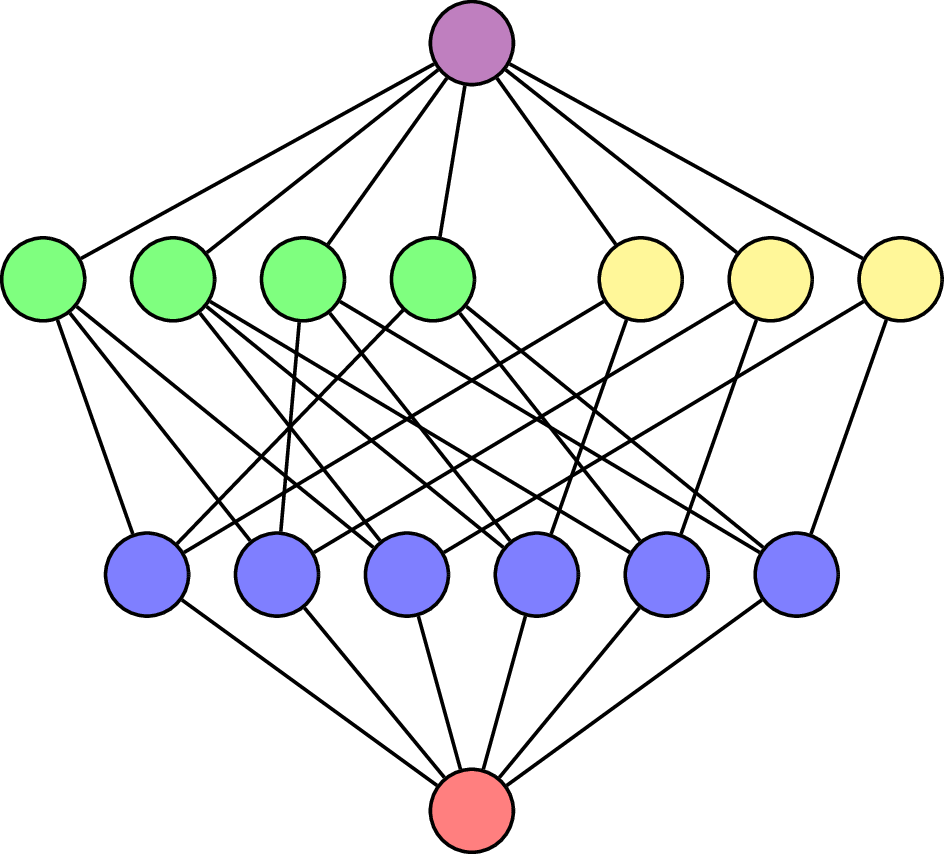Flag Hilbert–Poincaré series and Igusa zeta functions of hyperplane arrangements
Joshua Maglione
Bielefeld University
math.uni-bielefeld.de/~jmaglione
www.slides.com/joshmaglione/cirm2021



Joint with ...

Igusa's zeta functions
Count roots of \(f\in\Z[X_1,\dots, X_d]\): let \(p\) be a prime,
Igusa's zeta function – \(p\)-adic integral closely related to
Of interest: \(f\) a product of linear polynomials.
Goal: use combinatorial & topological tools to understand asymptotics and arithmetic of \(P_f(T)\) and Igusa zeta function.
Comes up in computing: subgroup, representation, & class counting zeta functions.
Flag Hilbert–Poincaré series
\(\mathcal{A}\) hyperplane arrangement – hyperplanes in \(K^d\)
\(\mathcal{L}(\mathcal{A})\) intersection poset – all nonempty intersections
Poincaré polynomial:
\(K\!=\!\mathbb{C}\)
\(\hat{1}\)
\(\hat{0}\)

\(\mathcal{L}(\mathcal{B}_4)\)
\(\mathrm{rk}\)
0
1
2
3
For \(F = (x_1 < \cdots < x_\ell)\in\Delta(\mathcal{L}(\mathcal{A}))\), with \(x_0=\hat{0}\), \(x_{\ell+1}=\varnothing\),
With \(x\in \mathcal{L}(\mathcal{A})\), two new arrangements
Example: \(\mathcal{A} = \mathcal{B}_4\)
Order complex: \(\Delta(\mathcal{L}(\mathcal{A}))\) – flags in \(\mathcal{L}(\mathcal{A})\)

\(F\) empty flag in \(\Delta(\mathcal{L}(\mathcal{A}))\):

\(F = (\quad\;)\):
















\(F = (\quad\;<\;\quad)\):

Set \(\widetilde{\mathcal{L}}(\mathcal{A}) = \mathcal{L}(\mathcal{A})\setminus\{\hat{0}\}\) and \(\mathcal{A}\) is central if \(\bigcap_{H\in\mathcal{A}} H \neq \varnothing\)
The flag Hilbert–Poincaré series:
Thm (M.–Voll 2021). For \(\mathcal{A}\) defined over characteristic \(0\) and central, then
Self-reciprocity
Idea: \(\mathsf{fHP}_{\mathcal{A}}\) is equivalent to a \(p\)-adic integral.

\(\mathcal{L}(\mathcal{B}_4)\)
Igusa zeta function: a substitution of \(\mathsf{fHP}_{\mathcal{A}}(Y, \bm{T})\).
Igusa zeta function of \(f_{\mathcal{B}_4}\): for all primes \(p\),




Class counting zeta function: a substitution of \(\mathsf{fHP}_{\mathcal{A}}(Y, \bm{T})\).
\(\mathbf{G}\) a nilpotent group scheme of finite type over \(\mathbb{Z}_p\):
Set \(\Gamma = K_{3,2}\) and \(\mathbf{G}_{\Gamma}\) graphical group scheme.

\(\mathbf{G}_{\Gamma}(\mathbb{Z}_p)\) =
\(\leq\mathrm{GL}_{12}(\mathbb{Z}_p)\)
\( =\langle I + E_{1,2} + E_{5,7} + E_{6,8},~\dots, \)
\( I + E_{1,6} + E_{2,8} + E_{3,10} + E_{4,12}\rangle\)
\(\mathcal{C}_n\) coordinate hyperplanes in \(K^n\) and \(\mathcal{L}(\mathcal{C}_n)\cong 2^{[n]}\).
Class counting zeta function for \(\mathbf{G}_{\Gamma}(\mathbb{Z}_p)\) for all primes \(p\):






Details: Rossmann–Voll
A different coarsening
Set each \(T_x=T\) to get coarse flag Hilbert–Poincaré series:
Easier to see examples & other combinatorial properties.
Nice form:
Braid arrangement in \(\mathbb{Q}^n\):
All nonnegative coefficients. Computed with \(\mathsf{HypIgu}\).
Do coefficients of \(\mathcal{N}_{\mathcal{A}}(Y, T)\) have combinatorial interpretation?
Coxeter arrangements
The Eulerian polynomial \(E_n(T)\) is combinatorially defined.
Thm (M.–Voll 2021). For a Coxeter arrangement \(\mathcal{A}\) with no \(\mathsf{E}_8\) factors:
Conjecture (M.–Voll). For arbitrary \(\mathcal{A}\), the coefficients of \(\mathcal{N}_{\mathcal{A}}(Y, T)\) are nonnegative.
Apply combinatorial & topological tools from hyperplane arrangements to understand asymptotics and arithmetic of
Flag Hilbert–Poincaré series have combinatorial features:
Thm. \(\mathcal{A}\) central and characteristic \(0\) \(\implies\) \(\mathsf{fHP}_{\mathcal{A}}\) self-reciprocal.
Thm. \(\mathcal{A}\) Coxeter and no \(\mathsf{E}_8\)-factor \(\implies\) \(\mathcal{N}_{\mathcal{A}}(1, T)=\pi_{\mathcal{A}}(1)\cdot E_{\mathrm{rk}(\mathcal{A})}(T)\).
\(\mathsf{fHP}_{\mathcal{A}}\)
Igusa
cc z.f.
\(\mathsf{cfHP}_{\mathcal{A}}\)
Flag Hilbert--Poincaré series and Igusa zeta functions of hyperplane arrangements
By Josh Maglione
Flag Hilbert--Poincaré series and Igusa zeta functions of hyperplane arrangements
We define a class of multivariate rational functions associated with hyperplane arrangements called flag Hilbert--Poincaré series, and we show how these rational functions are connected to Igusa zeta functions. We report on a general self-reciprocity result and explore other connections within algebraic combinatorics. This is joint work with Christopher Voll.
- 1,133




